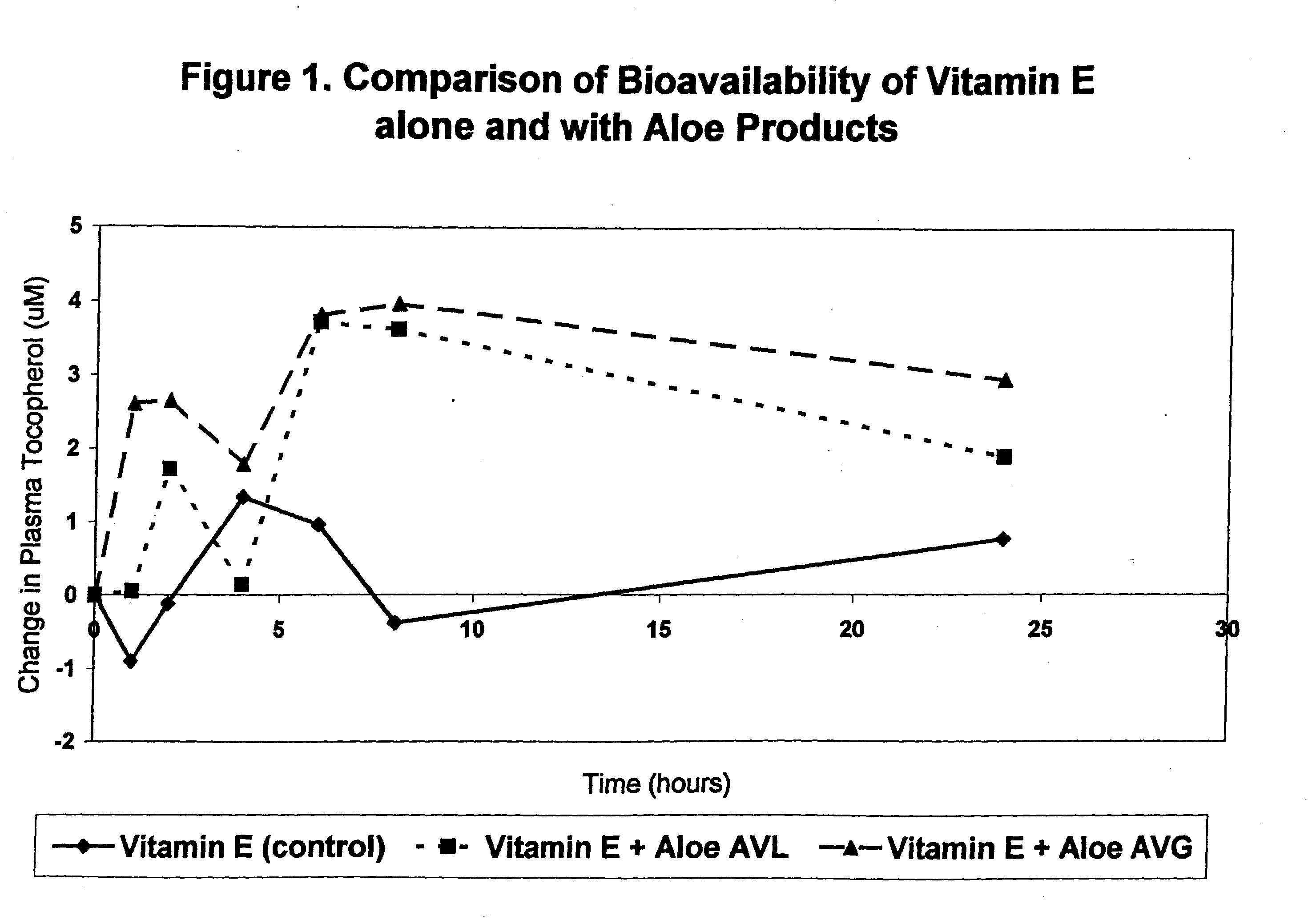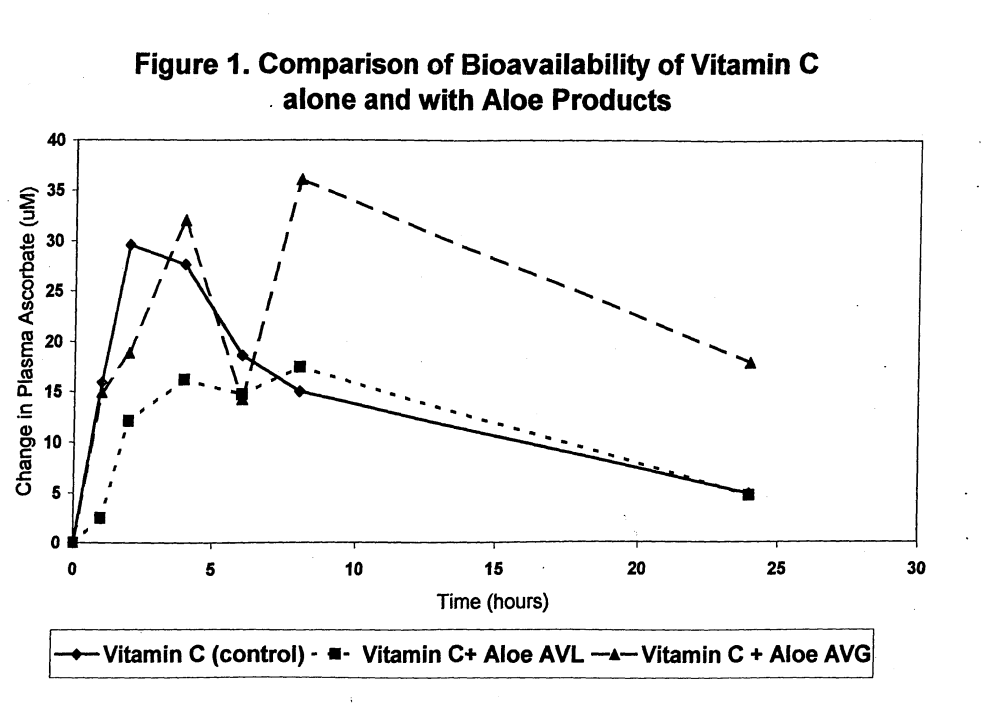Aloe Vera Gel Increases Absorption of Both Vitamins C and E
by Scott Siegel
J.
Vinson H. Al Kharrat, and L. Andreoli Department of Chemistry, University of Scranton, Scranton, PA
A search of the medical literature revealed that there are no articles describing the effect of aloe vera consumption on the absorption of either water-soluble or fat-soluble vitamins. Millions of Americans consume vitamins. A very large number of people also consume Aloe. Our research group took up the challenge of testing the effects of combined consumption of aloe and vitamins.
Does consuming aloe vera improve nutrient and vitamin absorption?
For water-soluble vitamin C, data was obtained on eight normal subjects. Two forms of aloe (AVL, a whole leaf extract, or AVG, a gel) liquid were tested in this study. The subjects appeared at a local clinical lab after an overnight fast and consumed in a random fashion 500 mg of a vitamin C tablet with either 60 mL (2 oz) of either water (control), AVG or AVL. The liquid was sipped over 5 minutes. Blood sampling was at 1, 2, 4, 6, 8 and 24 hours (fasting) post-dosing. Subjects were allowed to eat their normal lunch and evening meals. One week and two weeks later, the other liquids were consumed and the sampling repeated. Blood was converted to plasma, mixed with metaphosphoric acid preservative, and stored at -80°C until assay by HPLC. Changes in plasma ascorbate after consumption of the different liquids are shown in Figure 1. The areas under the average plasma ascorbate change with time curves correspond to the bioavailability. The areas were determined by a graphics program. The relative areas were as follows: vitamin C alone 100%, AVG 304% and AVL 80%. Thus, vitamin C was 3 times more bioavailable when taken with AVG but was 20% less bioavailable with AVL. The aloe preparations caused the absorption of ascorbate to be slowed as evidenced by the time for maximal absorption, which was two hours for vitamin C alone, eight hours for both AVL and AVG. A slow-release drug, for instance, usually has greater efficacy for a longer period of time. AVG also increased absorption and caused a larger ascorbate concentration at eight hours and 24 hours, thus providing more benefit. A review of the literature shows that aloe is only the second matrix that improves ascorbic acid absorption, the first being a citrus extract (1). Since vitamin C is the most common water-soluble vitamin supplement, this aloe result has wide-ranging applications.
Increasing Vitamin E & Vitamin C Absorption
Vitamin E is a fat-soluble vitamin that was given to 10 normal subjects. The same procedure as with vitamin C was followed except that vitamin E (tocopherol acetate) was given in the form of a soft capsule at a dose of 400 mg. The change in plasma E was calculated and illustrated in Figure 2. The vitamin E alone was poorly absorbed, as expected under fasting conditions, and in some time periods with the control the subjects had less E than at baseline, obviously an unhealthy situation. With the aloe preparations after consumption, the subjects had higher plasma E than at baseline at all times, even at 24 hours. Compared to the baseline, both aloes in Figure 2 had much higher changes in plasma E at eight and 24 hours. Thus the Aloes kept an elevated plasma E longer than the control without Aloes. The relative areas of the curves in Figure 3 were as follows: vitamin E alone using only the above baseline data 100%, AVL 198% and AVG 369%. Thus, vitamin E was two times more bioavailable with AVL and over three times more with AVG. The E absorption was slowed with the aloe liquids. The vitamin E taken alone produced a plasma E maximum at four hours, which then declined. The maximum occurred at six hours for AVL and eight hours for AVG. Aloe preparations taken with E greatly improved the absorption of vitamin E and maintained plasma E concentrations for longer periods of time compared to the vitamin E alone. Aloe is unique in its ability to improve the vitamin bioavailability of both vitamin C and E. In plain terms, aloe vera benefits health by drastically increasing vitamin absorption into the body.
The elderly population is greatly increasing in developed nations. This group is especially vulnerable to vitamin deficiency due to age-related decreases in absorption, reduced food intake and increased drug use (2). Hemodialysis patients have low levels of ascorbate that is further reduced with hemodialysis (3). It is well known that fats improve the absorption of the lipid-soluble vitamin E, but many people take vitamins on an empty stomach and dieters consume it with a low-fat meal. In addition, Orlistat, a fat absorption inhibitor used for weight loss (4), and Olestra, a fat substitute (5), significantly decrease plasma vitamin E when consumed for a long period of time. The results of our study indicate that aloe preparations can greatly improve the absorption of both a water- and fat-soluble vitamin, is of great significance, and a potential benefit to the population at large. The results of our study indicate that consuming aloe vera is one of the best ways to better absorb vitamins and minerals, and could therefore greatly improve the health of vitamin-deficient populations. Since aloe vera and vitamins C and E are commonly used in health cosmetics, the combination should be investigated to determine if aloe improves skin absorption of these vitamins.
A review of recent literature indicates that an ingredient of aloe has potent immunostimulatory activity (6) that has implications for wound healing and immunotherapy, perhaps providing greatest efficacy in combination with drugs where synergism could take place. An aloe leaf pulp extract showed hypoglycemic activity with type I (Insulin-Dependent Diabetes Mellitus) and type II (non-Insulin-Dependent Diabetes Mellitus) diabetic rats (7). In two rat models of arthritis, aloe significantly reduced paw swelling (8). Thus, scientific research should continue with aloe since many promising health benefits may result.


References
1. Vinson, J, Bose, P. Comparative bioavailabiity to humans of ascorbic acid alone or in a citrus extract.
Am. J. Cli Nutr 1988; 48: 601-4.
2. Van den Berg, H, and der Gaag M., Hendriks, H. Influence of lifestyle on vitamin bioavailabiity.
Mt. J. Vitamin Res. 2002; 72: 53-59.
3. Wang, S., Elde T., Sogn, E., Berg, J, Sund J. Plasma ascorbic acid in patients undergoing chronic
hemodialysis. Eur. J. Pharmacol 1999; 55: 527-532.
4. Melia, A., Koss-Twardy, S., Zhi, J. The effect of orlistat, an inhibitor of dietary fat absorption, absorption
of vitamins A and E in healthy volunteers. J. Clin. Pharmacol. 1996; 36: 647-653.
5. Kelly S., Shorthouse, M., Cotterell, J., Riordan, A., Lee, A., Thurnham, D., Hanka, R., Hunter, 3.
A 3-month, double-blind, controlled trial of feeding with sucrose polyester in human volunteers. Br J Nutr 1998; 80:41-49.
6. Pugh, N., Ross, S., ElSohly, M., Pasco, S. Characterization of Aloeride, a new high-molecular-weight
polysaccharide from Aloe vera with potent immunostimulatory activity. 3. Agric. Food Chem. 2001; 49:1030-1034.
7. Okyar, A., Can, A., Akev, N., Baktir, G., Sutlupinar, N. Effect of Aloe vera leaves on blood
glucose level in type I and type H diabetic rat models. Phytother. Res. 2001; 15:157-161.
8. Davis, R., Leitner, M., Russo, J., Byrne, M. Anti-inflammatory activity of Aloe vera against a spectrum
of irritants. 3. Am. Podiatr. Med. Assoc. 1989; 79: 263-276.
The product
statements have not been evaluated by FDA and the products are not intended to
diagnose, treat, cure or prevent any disease or medical condition. Contents of
this website are for informational purposes should not be used for diagnosing
or treating a health problem or disease.
|